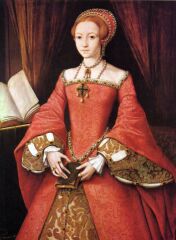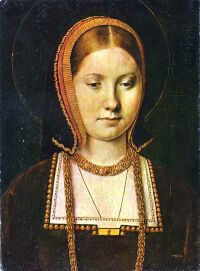 Unknown Artist c. 1546 Portrait of Princess Elizabeth |
Early in 2004 I
found a period looking brocade, and although I did not
really like the pastel colours (as bright dyes were more
expensive in the 16th century and therefore more popular
among the nobility) and it was a polyester/viscose blend
at $3 per metre I couldn't pass it up. At first I had
planned to make something Italian but Tudor just called
me back and I was inspired to make a new gown based on
Princess Elizabeth's portrait (left). I had also had
plans at the back of my mind to make an outfit from the
skin out, so I decided, as I already had an acceptable
smock, I would start with the kirtle and then fit the gown over it. For a while I debated whether to follow Ninya Mikhailya's example in her reconstruction of this gown and make my gown front lacing covered by a stomacher. However I decided that because the pointed waistline of the bodice a stomacher would be impractical.Because the stomacher would not have the weight of the skirts attached to it to keep it pulled down, I would need to either add boning to the stomacher or temporarily attach it to the bodice at waist to stop the point from flipping up when I moved. Because of the problems involved with a front lacing gown I decided it would be simpler just to make my gown back lacing. |

